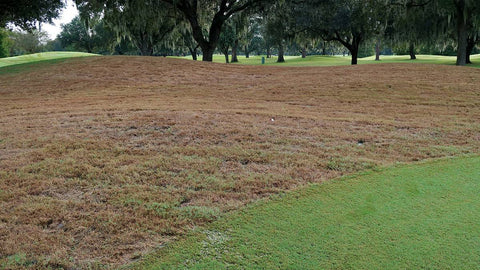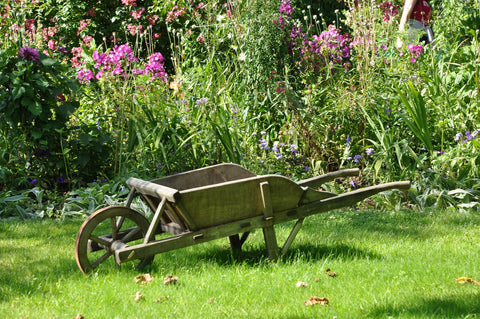Fall Armyworms are Invading Mid-Atlantic Yards
Beginning the 3rd week of August, we received reports of acute turf death in Harford and Baltimore Counties, MD and York County, PA. Our turf specialists were able to identify the cause of rapid browning of lawns as an infestation of fall armyworms. Over the next 2 weeks, we are getting multiple calls a day from homeowners and turf professionals. In several decades of managing turf, Mill specialists have not seen grass damage due to armyworms.
Where did they come from?
 Armyworms are a common turf pest in the south. Procedures to control these and other insects are part of regular lawn care practices. However, in the mid-Atlantic and Northeast, we rarely see fall armyworms. Some entomologists are speculating they were carried up from tropical storm Elsa on August 9th as insects and fungal spores can travel hundreds of miles on storm systems. Since then, reports are coming in from all the neighboring states.
Armyworms are a common turf pest in the south. Procedures to control these and other insects are part of regular lawn care practices. However, in the mid-Atlantic and Northeast, we rarely see fall armyworms. Some entomologists are speculating they were carried up from tropical storm Elsa on August 9th as insects and fungal spores can travel hundreds of miles on storm systems. Since then, reports are coming in from all the neighboring states.
How do armyworms destroy turf?
The larval stage of armyworms feed on leaves and sheaths of grass by scraping the leaf surface leaving a white or tan streak and chewing the leaf edges making leaf margins look ragged. Initially brown spots will appear, resembling a drought area. As larvae grow, they chow down on the lower leaf sheaths and are such voracious feeders and multiply so quickly that they can devastate an entire yard in days. Early detection is crucial to avoiding widespread damage as fall armyworms can quickly strip all of the green foliage from a turf area. On golf courses, feeding typically occurs within the rough and on newly sodded areas.
Life Cycle
One moth can lay hundreds of eggs which can hatch within 2-3 days in heat. The hatched larvae are tiny and move in large groups across the turf, giving  them the name armyworm. They mass feed for about 2 weeks developing into a 1” to 2” caterpillar that is green or brown with black stripes. before going into a pupate stage under the thatch and in the top layer of soil. Fall armyworm larvae can be identified by the characteristic, inverted white “Y” on their head. Pupae are oval shaped and reddish brown. In about a week, they emerge and are a gray and tan colored moth that will quickly lay between 500-1000 eggs, repeating the cycle in 3 weeks. Moths have a wingspan of about 1.5”. They are hard to see since they typically feed and fly at dusk.
them the name armyworm. They mass feed for about 2 weeks developing into a 1” to 2” caterpillar that is green or brown with black stripes. before going into a pupate stage under the thatch and in the top layer of soil. Fall armyworm larvae can be identified by the characteristic, inverted white “Y” on their head. Pupae are oval shaped and reddish brown. In about a week, they emerge and are a gray and tan colored moth that will quickly lay between 500-1000 eggs, repeating the cycle in 3 weeks. Moths have a wingspan of about 1.5”. They are hard to see since they typically feed and fly at dusk.
Signs of Infestation:
Early signs appear like a small patch of drought stress or turf disease. With large

infestations, if rain has been adequate, you can rule out drought. Fungal disease will not spread as quickly as armyworms. If you see brown spots that rapidly grow or radiate outward quickly, look closely for signs of pupae, larvae, or moths. In most instances, fall armyworm caterpillars will be visible under close inspection of the turf. A soapy water flush with lemon-scented dish soap can help to expose larvae that may be hiding in thatch layers.

Control Options:
Controlling armyworms is best done with an application of insecticide. Pyrethroids tend to be effective when designed to control surface feeding. An effective and recommended product The Mill recommends is a fertilizer with Acelepryn. It provides 2 modes of control – immediate contact kill and residual control. The insecticide is in small concentration, so it is fairly safe to apply. It must be watered in to make it effective. Acelepryn provides a rapid kill and offers protection for 3+ months. The additional fertilizer is desirable to rebound any damaged grass that is not chewed off at the crown and dead. Nutrients will help grass store up reserves to survive winter. If fertilizer with Acelepryn is not available or your yard is too small for a 50 lb. bag of fertilizer, you can use Bug Destroyer, a granular insecticide with the same active ingredient without fertilizer. Sevin can also be applied to turf. It is a low toxicity insecticide for people and pets. Fall armyworms are pretty easy to kill (bifenthrin, carbaryl, esfenvalerate, permethrin are effective among others) but by the time you see them they can devastate an area in a matter of days, so rapid detection and treatment is necessary to save turf.

Birds are a natural predator of armyworms; however, they will not usually be able to effectively fight the army of worms that quickly repopulate. Until a frost reduces the life cycle, we will be battling this army of pests for the next couple of months, so stay vigilant and observant!
Watch a video discussing the armyworm situation in early September:
Subscribe to The Mill's Twitter @TheTurfMill for updates on turf and weather topics and The Mill's YouTube channel for weekly weather forecasts and Turf Tips.











